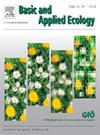Extensive vegetation management and semi-natural habitats increase plant alpha and gamma diversity in European vineyards
IF 3.5
2区 环境科学与生态学
Q2 ECOLOGY
引用次数: 0
Abstract
Permanent crops like vineyards have the potential to contribute to halting the biodiversity loss due to their spatiotemporal stability and lower disturbance frequency in vineyard inter-rows. However, anthropogenic pressures can be quite high in such agroecosystems and little is known about the relative impacts of local management intensity and landscape context on plant communities in viticultural landscapes. In this study, we examined how plant communities were affected by management intensity and landscape context in two European wine-growing regions. We established four plots within one inter-row and three transects in two neighbouring inter-rows and one undervine row in each of 70 paired vineyards (organic versus conventional farming) along a gradient of proportion of semi-natural habitats in the landscape. We analysed how alpha, beta and gamma diversity and plant species community composition at the vineyard scale responded to farming system, disturbance frequency, and semi-natural habitats. We found a positive impact of organic farming on alpha and gamma diversity and a significant influence of farming and transect type on species community composition. Besides farming system, disturbance frequency (tillage and mulching) reduced alpha diversity but increased beta diversity in the transects of both wine-growing regions. This difference could be attributed to the establishment of different plant communities of vineyards managed with higher or lower mulching and/or tillage intensity. At the landscape scale, higher proximity to and higher proportion of semi-natural habitats increased plant alpha and gamma diversity. Both landscape variables also explained significant variance of the plant community composition. Conservation of farmland biodiversity in vineyards should focus on supporting low-intensity diversified management operations and increasing shares of semi-natural habitats in the landscape.
广泛的植被管理和半自然栖息地增加了欧洲葡萄园植物α和γ的多样性
像葡萄园这样的永久性作物由于其时空稳定性和较低的干扰频率,有可能有助于阻止生物多样性的丧失。然而,在这样的农业生态系统中,人为压力可能相当高,而且人们对当地管理强度和景观背景对葡萄栽培景观中植物群落的相对影响知之甚少。在这项研究中,我们研究了两个欧洲葡萄酒产区的植物群落如何受到管理强度和景观环境的影响。我们沿着景观中半自然栖息地的比例梯度,在70个成对的葡萄园(有机与传统农业)中,在一个行间内建立了四个地块,在两个相邻的行间和一个藤蔓行中建立了三个横断面。我们分析了葡萄园尺度上的α、β和γ多样性和植物物种群落组成对耕作制度、干扰频率和半自然生境的响应。结果表明,有机耕作方式对α和γ多样性有显著的正向影响,而耕作方式和样带类型对物种群落组成有显著的影响。除耕作制度外,干扰频率(耕作和覆盖)降低了两个葡萄酒产区样带的α多样性,但增加了β多样性。这种差异可能是由于不同覆盖和/或耕作强度的葡萄园建立了不同的植物群落。在景观尺度上,与半自然生境的接近程度越高,半自然生境所占比例越高,植物α和γ多样性增加。这两个景观变量也解释了植物群落组成的显著差异。葡萄园的农田生物多样性保护应侧重于支持低强度的多样化经营,并增加半自然栖息地在景观中的份额。
本文章由计算机程序翻译,如有差异,请以英文原文为准。
求助全文
约1分钟内获得全文
求助全文
来源期刊

Basic and Applied Ecology
环境科学-生态学
CiteScore
6.90
自引率
5.30%
发文量
103
审稿时长
10.6 weeks
期刊介绍:
Basic and Applied Ecology provides a forum in which significant advances and ideas can be rapidly communicated to a wide audience. Basic and Applied Ecology publishes original contributions, perspectives and reviews from all areas of basic and applied ecology. Ecologists from all countries are invited to publish ecological research of international interest in its pages. There is no bias with regard to taxon or geographical area.
 求助内容:
求助内容: 应助结果提醒方式:
应助结果提醒方式:


